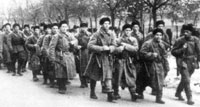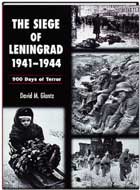|


The Soviet Union During World War II
1941
On June 22, 1941 German troops invaded the Soviet Union with-out prior notification or a declaration of war. The soviets were greatly out-numbered in terms of equipment, troops and supplies. After the first day of war the Soviets already lost 50 kilometers to the Germans. Within the first three weeks of battle the Soviets lost 20-30 kilometers a day in land, and a number of troops each day. By mid July the Germans had already occupied the countries of the Ukraine, Lavita, and Lithuania. The loss of troops and land mounted.
By August the Germans were advancing in all directions. In the North they were determined to seize Leningrad. In the middle the Germans were marching toward Moscow in an attempt to destroy the Capital. By the end of August the Germans had taken over 500 kilometers of territory.
The Seize of Leningrad.
On July 10th the Germans were already starting to colse in on Leningrad. By August the railroad, and other transporation methods ceased. The only way out was through a small lake and rarely by air.
On September 8th all land communication stopped and the 900 day siege of Leningrad began. On November 20 the Citizens of Leningrad began to starve when food rations dried up. Many would die from starvation in the following 900 days in Leningrad. By the end of 1941 more than 1.5 million square kilometers were now in the hands of the Germans. The soviets were fighting along a 1000 kilometer front and fore than 5.3 million people were killed, captured. The losses were staggering for both Civilians and Soviet Troops.
|
|
The Battle for Moscow
The Nazi army was intent to capture the key cities of Moscow, Leningrad, and Stalingrad. Hitler sent a majority of the available tanks to assist in the siege of Leningrad. To prevent any further advancement by other German forces Soviet Red Army Marshal Georgi Zhukov. He was a tough and wily officer who also assisted with the defense of Leningrad. Zhukov's main goal to organize the remaining Soviet
Troops. The only luck the Soviets had in 1941 was that the winter came early and it came without warning. The German troops, tankswere caught off guard by the hears Russian winter. The high winds
caused severe frost bite. Temperatures plummeted to -20 degrees(Fahrenheit) below zero. Any flesh that was exposed for more than a fewseconds became frost bitten. More casualties resulted due to frostbite than from bullets. The cold weather also caused severe equipment problems. Engines froze, and broke down.
At the same time the fighting continued. By November 28, 1941 the Germans were in Eyeshot to the Kremlin, but they were extremely low on endurance. 750,000 Troops had been injured and 200,000 soldiers killed, this is seven times larger than all the German casualties in 1940.
On December 5,1941 the Soviets began a counter offensive. It developed a massive movement of Troops and equipment. The Germans retreated out of Moscow, due to massive troop loss, dysentery, Frostbite, weapons and vehicles jamming in the cold caused the Germans to retreat
|
 |
The Siege of Leningrad
The siege of Leningrad (Leningrad originally called St. Petersburg,When Lenin died in 1924, the city was renamed Leningrad in his
honor, the original name of St. Petersburg was restored in 1991) was
one of the most tragic events of World War II. The siege lasted from
September 8,1941 until January, 27 1944. ALMOST 900 DAYS!!!!! The
siege began less than 2 and one-half months after the original
German invasion of the Soviet Union. Almost 2,887,000 civilians and
Troops were trapped and under siege.
The citizens of Leningrad refused to surrender. Available food and fuel
supplies were extremely limited. All public transportation stopped and
by the Winter of 1941 the fuel for heat was gone, and little water and
food remained. Food rations were limited to 1/4 of a pound per person
per day!!! Due to these limited food supplies, and lack of heat by the
end of February 1942, 200,000 people died!!!
Before the winter of 1942 ended several hundred people were
evacuated across a frozen lake. The lake was deemed "Road of Life",
that was the only way out during the winter. During the spring and
summer other citizens were ferried to the mainland.
In January 1943 the Siege was broken and a year later on January
27,1944 the siege was over. It is estimated that over 800,000 people
died as a result of the Siege.
|
 |
The Siege of Stalingrad
Stalingrad (Currently called Volgograd, Its was named Stalingrad in
1925, and was renamed Volgograd in 1961 when Krushchev
denounced Stalin) was under siege from September 1942 until
February of 1943. 500,000 German troops stormed the city. Joseph
Stalin ordered that the city be saved at all costs. After approximately two
months of fighting (mostly house to house) the Germans contorted a
majority of the city. The citizens of Stalingrad underwent many of the
same hardships of the citizens of Leningrad.
In November 1942 a second German invasion of Stalingrad began. This
time the Soviets were successful in containing the Germans. The
Germans withdrew from Stalingrad on February 2,1943. From there the
Soviets began a westward drive and remained on the offensive for a
majority of the war after that
|
|
|
|
|
|
|
|
|
|
|
|
|
|
|
|
|
|
|
|
|
|